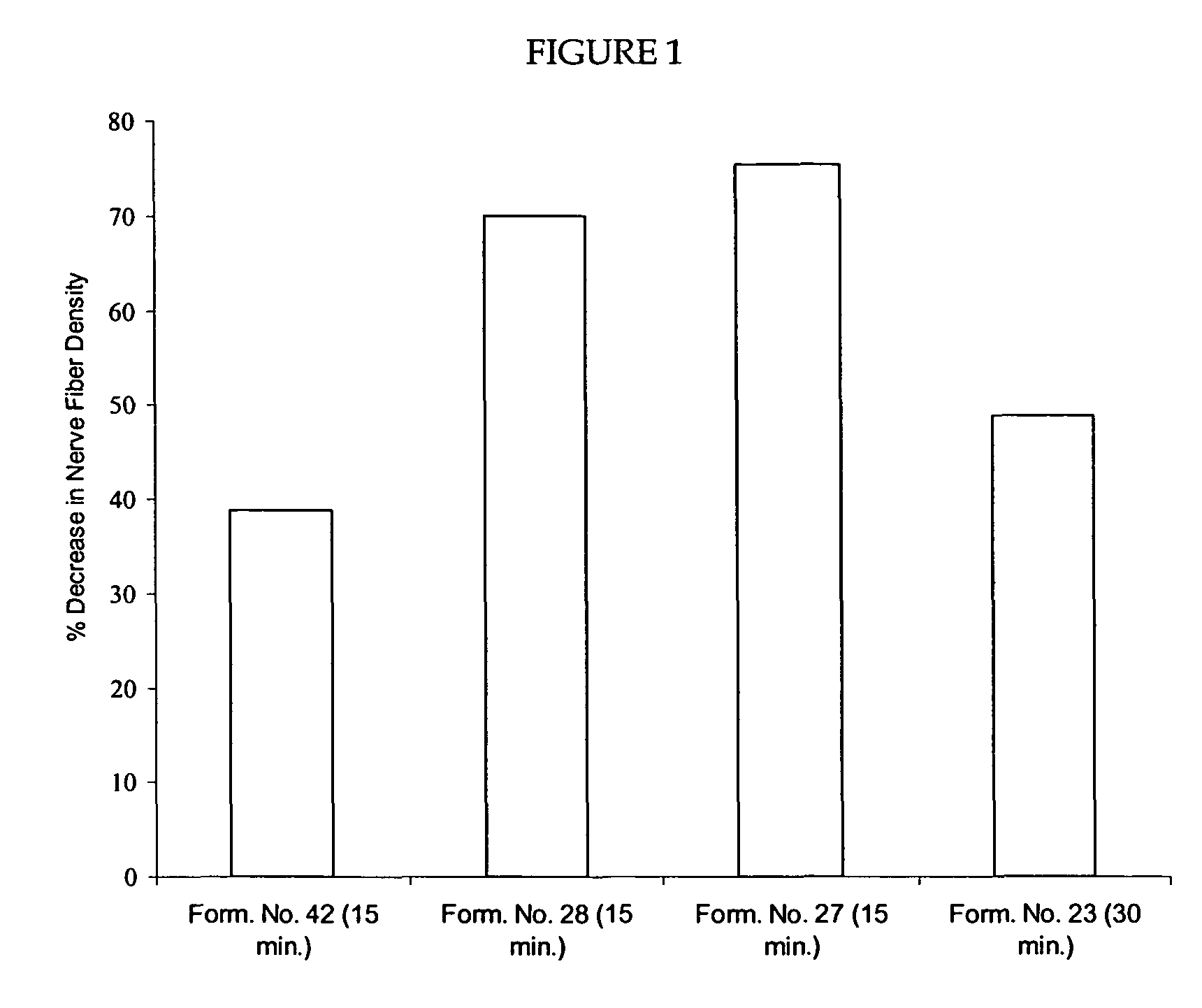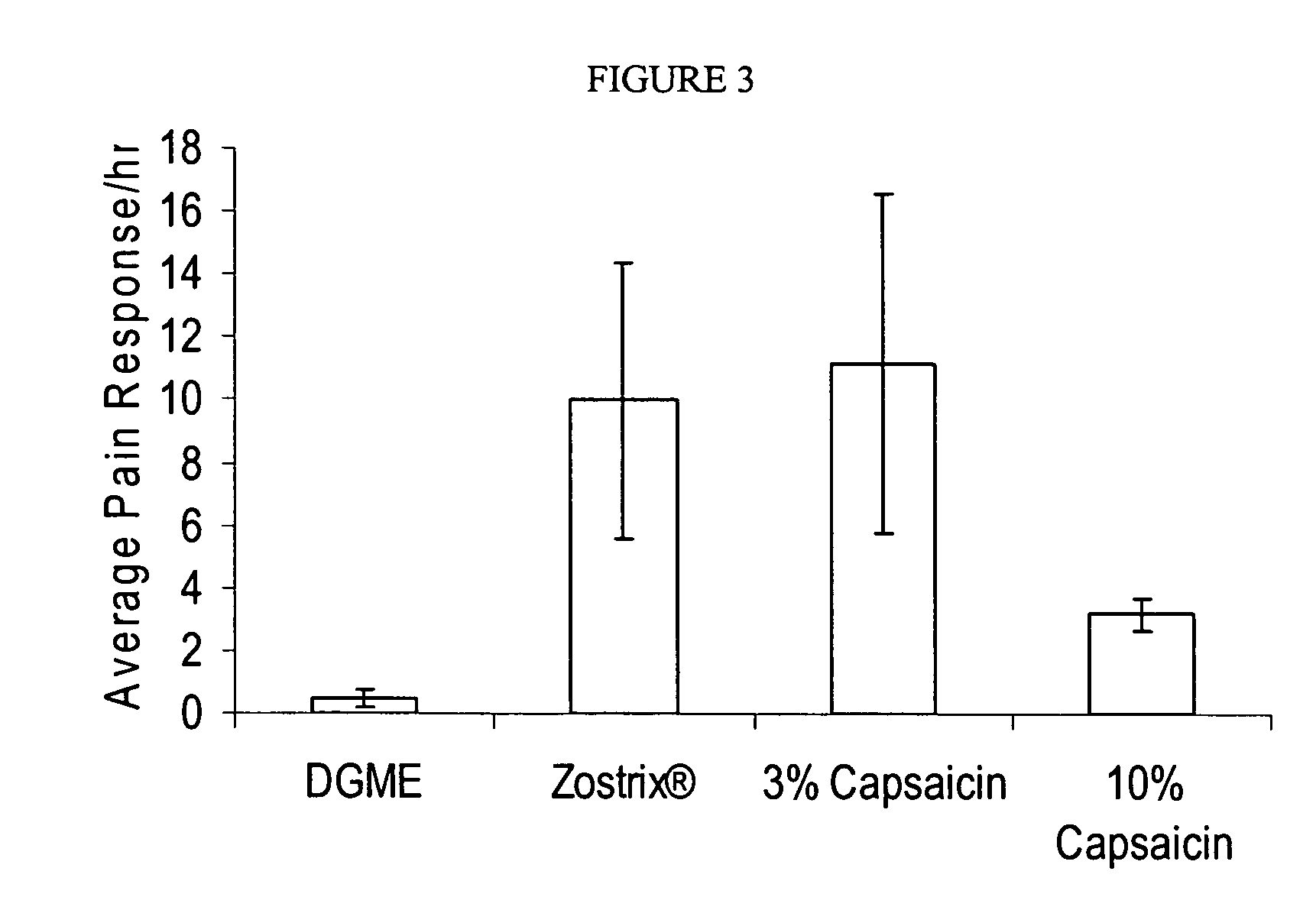Methods and compositions for administration of TRPV1 agonists
a technology of trpv1 and agonist, which is applied in the direction of drug composition, biocide, metabolic disorder, etc., can solve the problems of limited use, long-term yet reversible impairment of nociceptor function, and various types of chronic pain, and achieve the reduction of the density of functional nociceptive nerve fibers in the epidermis and dermis.
- Summary
- Abstract
- Description
- Claims
- Application Information
AI Technical Summary
Benefits of technology
Problems solved by technology
Method used
Image
Examples
example 1
Determination of TRPV1 Agonist Content Using the Mouse Skin Absorption Assay and Demonstration of Rapid and Efficient Delivery of TRPV1 Agonists to Mammalian Skin
[0256]This example shows delivery of TRPV1 agonists using various compositions, and described the “mouse skin absorption assay.” The mouse skin absorption assay is an in vitro assay for measuring the delivery and retention of a TRPV1 agonist. The assay is generally as described by Kemppainen and Reifeinrath, 1990, in METHODS FOR SKIN ABSORPTION, CRC Publication (hereinafter, “Kemppainen”), with the following modifications: Tissue that was not used on the day of animal sacrifice was stored at less than −70° C., rather than at less than −60° C., until the day of the experiment; and 3H2O with a specific activity of ˜0.5 μCi / mL (rather than ˜0.3 μCi / mL) was used, and the receptor solution was collected and analyzed at 30 minutes, rather than 20 minutes as described in Kemppainen.
Skin Preparation
example 2
Reduction of Nerve Fiber Functionality in Nude Mouse Skin
[0265]This example shows a reduction of nerve fiber functionality (NFF) as demonstrated by PGP 9.5 immunostaining following application of capsaicin to mouse skin. The experiments were performed on 8-12 week old nude mice (Nu / Nu) (Charles River). The mice were acclimated and arbitrarily divided into either 2 dose groups (for Experiment 1) of 12 mice per group (6 male and 6 female) or 4 dose groups (for Experiment 2) of 20 mice per group (10 male and 10 female).
[0266]In Experiment 1, On Day 0, 15 μL of 10% (w / v) capsaicin in 100% diethylene glycol monoethyl ether (DGME) and 0.1% (w / v) ethyl cellulose (i.e., Formulation No. 23 containing 0.1% ethyl cellulose) was applied to a 1 cm×1 cm area on the back of anesthetized mice of one group, while the control group received DGME dispersed in an adhesive matrix. In Experiment 2, On Day 0, 15 μL of either 15% (w / v) capsaicin in 15% oleic acid, 10% isopropyl myristate, 10% cetyl alcohol...
example 3
Reduction of Nerve Fiber Functionality in Rat Vulva
[0268]This example shows the effect of local application of TRPV1 agonist formulations to rat vulva.
[0269]Sixty female retired breeder Sprague-Dawley rats were divided into 6 groups. On day 0, rats were anesthetized with isoflurane anesthetic gas and then LMX5® anesthetic cream was applied to the entire vulvar area of each rat at least 30 minutes. The test formulations were applied using a micropipette to dispense 33 μL of each formulation. The formulations applied were diethylene glycol monoethyl ether (DGME) alone; 0.01% capsaicin (w / v) in DGME; 0.1% capsaicin (w / v) in DGME; 1% resiniferatoxin (w / v) in DGME; 3% capsaicin (w / v) in 90% (v / v) DGME and 10% (v / v) DMSO, a 10% capsaicin (w / v) in DGME. The formulations were left on for 20 minutes with the exception of 10% capsaicin (w / v) in DGME which was left on for 5 minutes. The remaining formulation was removed using a cleansing gel (89.08% PEG 300, 1.0% Carbopol 1382™, 0.02% butylate...
PUM
| Property | Measurement | Unit |
|---|---|---|
| v/v | aaaaa | aaaaa |
| v/v | aaaaa | aaaaa |
| area | aaaaa | aaaaa |
Abstract
Description
Claims
Application Information
 Login to View More
Login to View More - R&D
- Intellectual Property
- Life Sciences
- Materials
- Tech Scout
- Unparalleled Data Quality
- Higher Quality Content
- 60% Fewer Hallucinations
Browse by: Latest US Patents, China's latest patents, Technical Efficacy Thesaurus, Application Domain, Technology Topic, Popular Technical Reports.
© 2025 PatSnap. All rights reserved.Legal|Privacy policy|Modern Slavery Act Transparency Statement|Sitemap|About US| Contact US: help@patsnap.com



